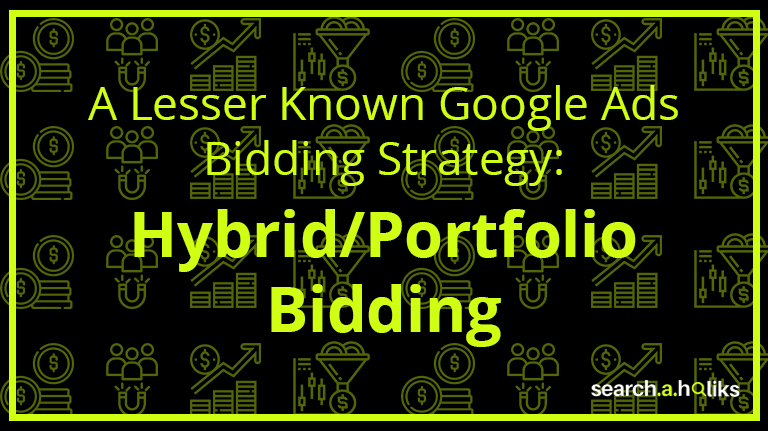Google ads have been the lifeline for most brands who wish to break ahead of the competition. Organic traffic brings the most business for the minimum investment, and you need to focus on getting organic leads to your website. Yet, reaching that level requires months and even years of constant optimization, and display ads tend to accelerate the process of lead acquisition.
Yet, it is easy to get lost for someone circumnavigating around the innumerable settings and options in the Google Ad dashboard. You need to consider the target audience, the bid value, and the campaigns’ goals before creating the campaign. Google helps you out with automated bidding to simplify the learning curve. With time and practice, you turn into someone for whom bidding becomes the back of their hand. You begin to manually set the bidding value, never to look back at the automatic bidding option. Yet, a true PPC expert does not manage an ad campaign by running it manually. They know how to use both bidding types to run their campaigns, and such a strategy is called Hybrid Bidding.
Understanding the different Google Ads Bidding Strategies
In Google ads lingo, any kind of bidding determines the cost per click (CPC) or cost per acquisition (CPA) for increasing the likeliness of a specific ad to achieve any of the following goals:
- Increase clicks
- Improve conversions
- Better visibility in search results
- Superior conversion value
There are two major bidding types in addition to the Hybrid Bidding strategy.
Automated Bidding
Automated bidding is sort of your partner when you are learning the ropes of different bidding strategies. The AI does all the heavy lifting and removes the guesswork from determining the correct bid value that helps you meet your performance goals. To avoid overspending, you need to specify the maximum cost-per-click for each campaign.
Pros:
- Ideal for those starting out
- Reduce the time spent on campaign monitoring
- You have specific goals
- Better audience segmentation
- Better accuracy in ad performance prediction
Cons:
- You can quickly run your budget out if not careful
- Inconsistent delay in sync
- This can work for campaigns with existing good traffic flow and conversion volume.
- Need larger PPC budget to compensate the trial and error
Manual Bidding
Manual bidding, on the other hand, allows you to fine-tune every aspect of your ad campaign. You can allot the different cost-per-click values for individual ad campaigns and specify the maximum CPC value for the entire ad group. Based on the profitability of individual keywords, you can allocate more advertising budget to that keyword. Manual bidding allows marketers to make crucial decisions on ad visibility and take action without depending on any AI assistance or smart solutions.
Pros:
- It can be done with a smaller budget
- Works for a small amount of conversion data
- Better control over ad campaigns
- Faster execution of changes
- Immediate ad performance response
Cons:
- Need significant time to be spent on campaigns
- It can become difficult to keep track of multiple campaigns
- Room for human error
- Limited segmentation options
Hybrid Bidding
Hybrid bidding allows the marketers to have the best of both worlds. By definition, hybrid bidding is an automated bidding strategy that will enable you to group together multiple ad campaigns, keywords, and ad groups for achieving your campaign goals. Using hybrid bidding strategies, you get better optimization speed based on the AI learning speed. Hybrid bidding is also known as portfolio bidding strategy, as any created strategy is stored in the shared library, ready to be applied to any applicable campaign. With the hybrid bidding strategy, you allow the AI to set the bids for campaigns to match your performance goals (like automatic bidding), and you can quickly change the bidding settings from a single place (like manual bidding).
Why Choose Hybrid Bidding Strategy?
Hybrid bidding is a supercharged version of automatic bidding strategies, where you create individual ‘portfolios’ that can be reused for other campaigns with similar goals. Marketers get a better insight into their bidding efforts. Using the hybrid bidding strategies, you can make specific changes across set campaigns, ad groups, and keyword targeting. This takes away the strenuous task of manually setting the bid amounts for ad groups and individual keywords.
You can achieve the same accuracy and consistency of manual bidding, but you allow machine learning to evaluate the campaign performance and optimize the campaigns on your behalf. Over-segmented campaigns based on other account goals such as controlling the budget, match types, devices, audiences, etc., can be simplified and grouped together under a single portfolio strategy. In theory, switching over to hybrid bidding can grant you more conversions or clicks.
Who should use Hybrid/ Portfolio Bidding Strategy?
If you are looking to reduce the overall CPA value of your existing campaigns or wish to compete on specific keywords on a limited budget, hybrid Google ads bidding strategy is the way ahead. Marketers who want to target specific CPA values without splurging on the CPC can use the strategy to avoid high CPC keywords and add an extra layer of insurance. You can run a portfolio on campaigns based on the following segments:
- Location
- Audience
- Match Type
- Themes
When not to use Hybrid Bidding Strategy?
Many marketers use portfolio bidding, but it might not be everyone’s cup of tea. Since hybrid bidding is a type of automatic bidding strategy, it requires some amount of historical data to start the optimization techniques. Someone who has recently launched a brand from scratch may want to stick to manual bidding until they have built some historical data and have a baseline CPA.
How to plan your strategy using Hybrid Bidding
Before creating a new portfolio, there are two prerequisites for you to complete:
- Identify all campaigns with the same KPI and goal
- Create a shared budget target for all the collective campaigns
Now moving on to the next part, i.e., creating the bidding portfolios for each collective campaign.
Step 1: Create a portfolio strategy with a new campaign
- Sign in to your Google Ads account.
- Click Campaigns.
- Click the plus button and choose your campaign type.
- In the “Bidding” section, select your bid strategy from the drop-down menu.
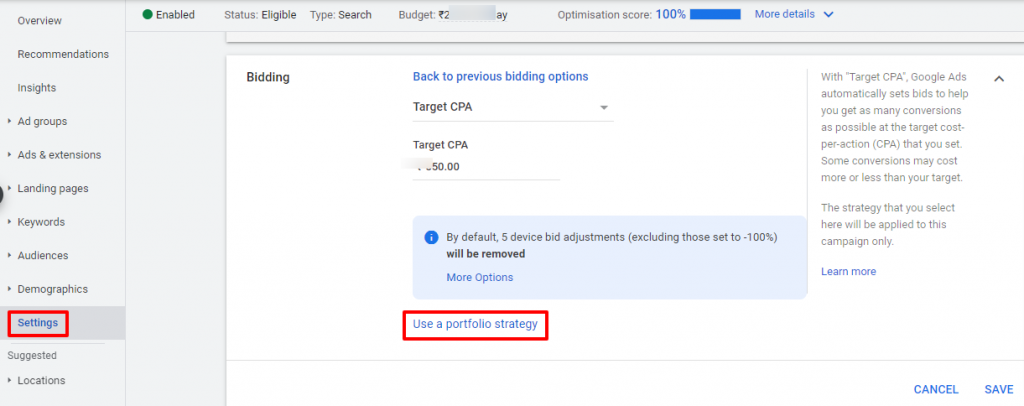
- Click Use a portfolio strategy.
- Choose Create a new portfolio strategy.
- Enter the settings for your new strategy, and give it a name.
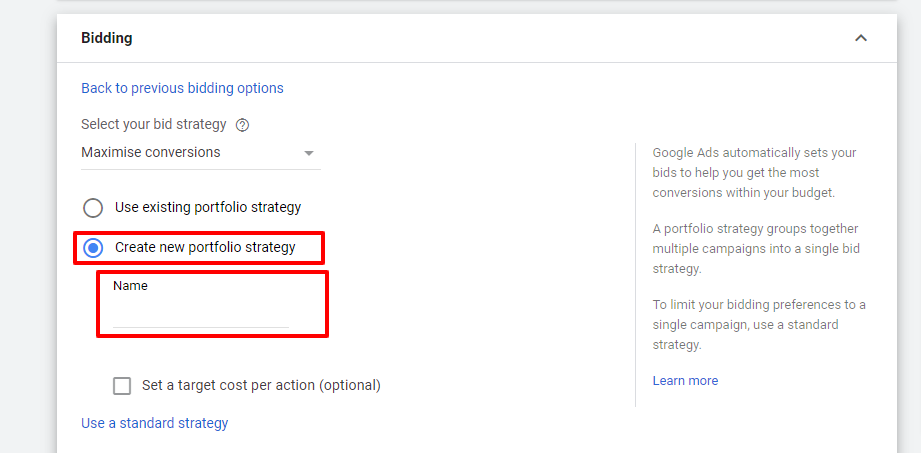
Step 2: Create a portfolio strategy in campaign settings
- Sign in to your Google Ads account.
- Click Campaigns.
- Click the campaign you’d like to edit.
- Click Settings and scroll down to the “Bidding” settings.
- Click Change bid strategy, and then Use a portfolio bid strategy.
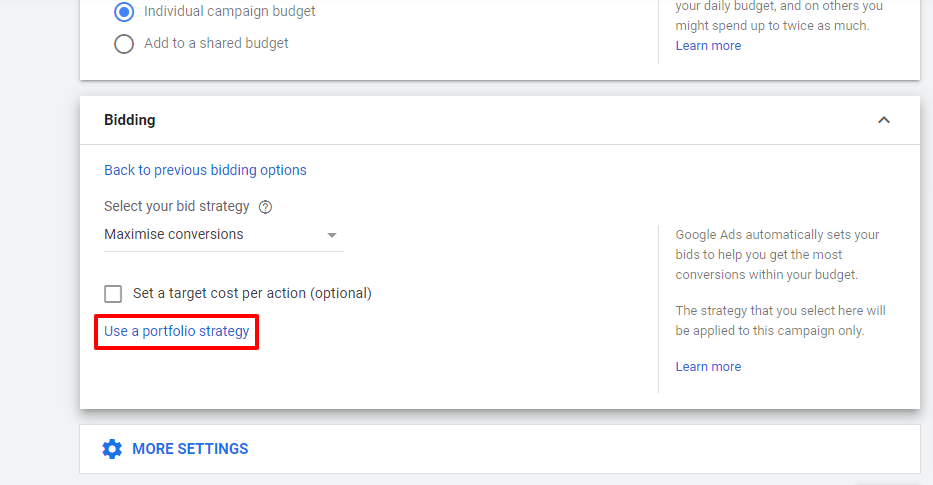
- You can choose to ‘Create a new portfolio strategy’ or ‘Use an existing portfolio strategy.’
- If you Use an existing portfolio strategy, select a strategy from the list provided.
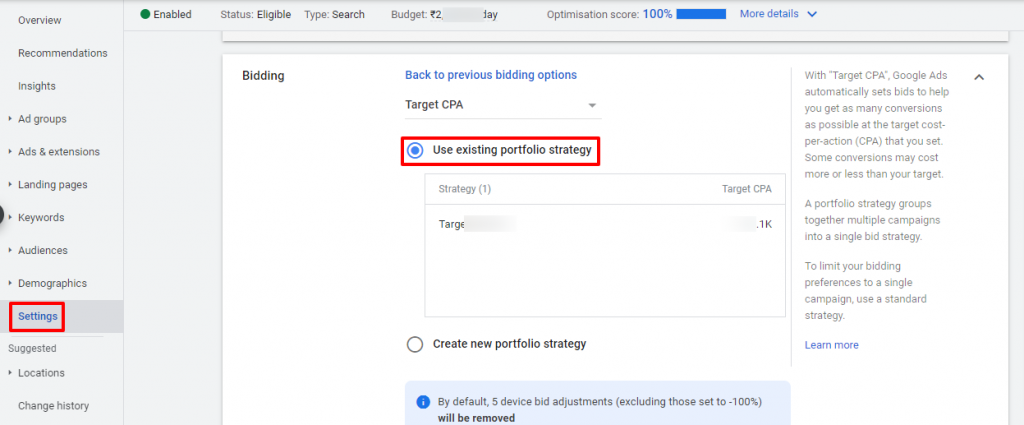
- If you ‘Create a new portfolio strategy,’ enter the settings for your new strategy, and give it a name

- If you Use an existing portfolio strategy, select a strategy from the list provided.
- Click Save
Step 3: Create a portfolio strategy in the Shared library
- Sign in to your Google Ads account.
- In the upper right corner of your account, click the tool icon Google Ads | tools [Icon], then under “Shared library,” select bid strategies.

- Click the plus button, and choose the type of bid strategy you’d like to create.
- Enter the settings for your new portfolio bidding strategy, and click Save.

Wrapping Up
When it comes to running Google Ads campaigns, every marketer needs to make the correct judgment about the bidding value of the campaign. Yet, with actual money on the line, everyone has a lesser tolerance for conducting trial and error. By using the hybrid bidding strategies, you will be able to take your ad campaign performance to the next level. You stand to gain the best CPA with an additional insurance layer of low CPC thrown in the mix. If you need more information about the portfolio bidding strategy or you need someone to manage your ad campaigns, share your requirements to hi@searchaholiks.com and we shall get back to you soon.
Was this page helpful?
Team Searchaholiks
Team Searchaholiks believes that sharing knowledge can help the community grow. Hence, we regularly post articles covering the most common pain points of our clientele. However, for a quicker resolution of your issues, drop us your requirements at hi@searchaholiks.com.
 liks
liks